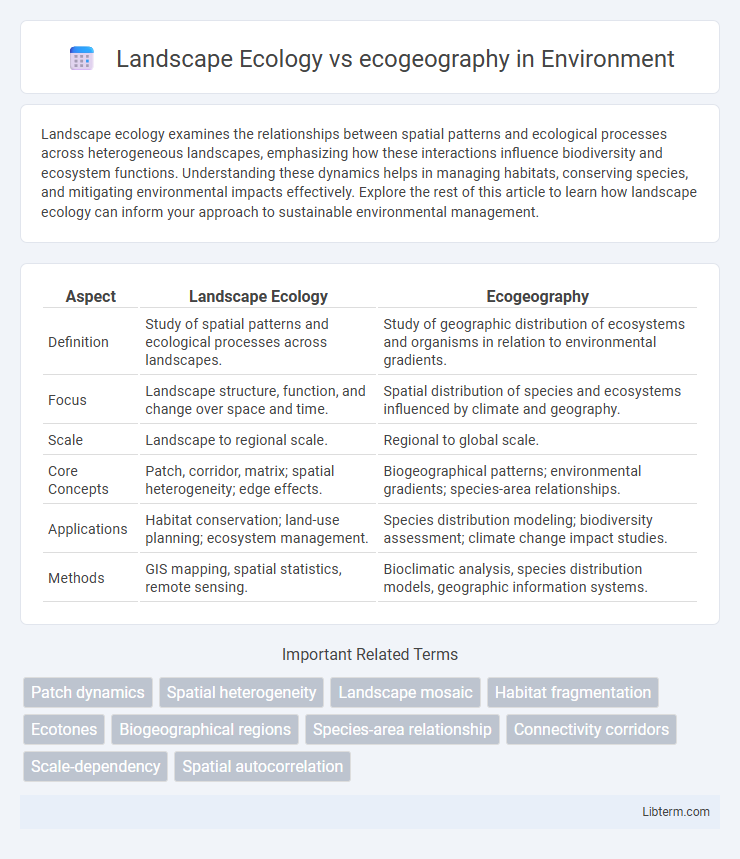Landscape ecology examines the relationships between spatial patterns and ecological processes across heterogeneous landscapes, emphasizing how these interactions influence biodiversity and ecosystem functions. Understanding these dynamics helps in managing habitats, conserving species, and mitigating environmental impacts effectively. Explore the rest of this article to learn how landscape ecology can inform your approach to sustainable environmental management.
Table of Comparison
| Aspect | Landscape Ecology | Ecogeography |
|---|---|---|
| Definition | Study of spatial patterns and ecological processes across landscapes. | Study of geographic distribution of ecosystems and organisms in relation to environmental gradients. |
| Focus | Landscape structure, function, and change over space and time. | Spatial distribution of species and ecosystems influenced by climate and geography. |
| Scale | Landscape to regional scale. | Regional to global scale. |
| Core Concepts | Patch, corridor, matrix; spatial heterogeneity; edge effects. | Biogeographical patterns; environmental gradients; species-area relationships. |
| Applications | Habitat conservation; land-use planning; ecosystem management. | Species distribution modeling; biodiversity assessment; climate change impact studies. |
| Methods | GIS mapping, spatial statistics, remote sensing. | Bioclimatic analysis, species distribution models, geographic information systems. |
Introduction to Landscape Ecology and Ecogeography
Landscape Ecology examines spatial patterns and ecological processes across heterogeneous landscapes, emphasizing interactions between ecosystems, land use, and biodiversity. Ecogeography explores the geographic distribution of species and ecosystems in relation to environmental factors such as climate, topography, and soil. Both fields integrate spatial analysis but Landscape Ecology focuses more on landscape structure and function, while Ecogeography emphasizes species distribution and environmental gradients.
Core Concepts of Landscape Ecology
Landscape ecology centers on the spatial patterns and ecological processes across heterogeneous land mosaics, emphasizing patch dynamics, corridors, and matrix interactions. Core concepts include scale, spatial heterogeneity, and landscape connectivity, which influence biodiversity, ecosystem functions, and species movement. Ecogeography, in contrast, focuses on geographic distribution of organisms related to environmental gradients, often using species-environment correlations without the explicit spatial pattern analysis central to landscape ecology.
Fundamental Principles of Ecogeography
Ecogeography fundamentally examines the spatial distribution patterns of ecosystems and species in relation to environmental gradients such as climate, topography, and soil types. Landscape ecology, while overlapping, emphasizes the heterogeneous patterns and ecological processes across spatial scales within landscapes, including patch dynamics and connectivity. The core principles of ecogeography involve understanding species-environment relationships, biogeographical barriers, and the influence of abiotic factors on biodiversity distribution, which are critical for conservation planning and predicting ecological responses to environmental changes.
Key Differences Between Landscape Ecology and Ecogeography
Landscape ecology studies spatial patterns and ecological processes across heterogeneous land mosaics, emphasizing spatial scale, structure, and connectivity of ecosystems. Ecogeography focuses on the distribution of organisms and ecosystems in relation to climatic, geological, and environmental factors, analyzing geographical patterns of biodiversity and species adaptation. Key differences include landscape ecology's focus on spatial heterogeneity and ecosystem interactions versus ecogeography's emphasis on species distribution and environmental correlates over large geographic scales.
Methods and Approaches in Landscape Ecology
Landscape ecology employs spatial analysis tools such as GIS, remote sensing, and landscape metrics to study the patterns and processes across heterogeneous landscapes. Methods emphasize scale-dependent interactions, patch dynamics, and connectivity to understand ecological flows and landscape structures. These approaches contrast with ecogeography, which primarily focuses on species distribution and environmental gradients using biogeographical and climatic modeling techniques.
Techniques and Tools in Ecogeography
Ecogeography utilizes spatial analysis tools such as Geographic Information Systems (GIS), remote sensing, and ecological niche modeling to map species distributions and environmental gradients. Techniques like habitat suitability modeling and climate data integration enable the prediction of species responses to environmental changes. These tools provide a quantitative framework to analyze biogeographical patterns, complementing landscape ecology's focus on spatial structure and ecosystem processes.
Scales of Analysis: Landscape vs Global Patterns
Landscape ecology emphasizes spatial patterns and ecological processes at local to regional scales, focusing on habitat mosaics, patch dynamics, and interactions within specific landscapes. Ecogeography examines global distribution patterns of species and ecosystems, linking environmental gradients to biogeographical trends on a planetary scale. The analysis in landscape ecology typically involves finer-scale spatial heterogeneity, whereas ecogeography addresses broader-scale climatic and evolutionary influences shaping biodiversity across continents.
Applications in Conservation and Land Management
Landscape ecology provides critical insights into spatial patterns and ecological processes that help design effective conservation corridors and habitat restoration projects, enhancing biodiversity preservation. Ecogeography contributes valuable data on species distributions and environmental gradients, guiding targeted land management strategies under changing climatic conditions. Both fields integrate geographic information systems (GIS) and remote sensing tools to optimize conservation planning and adaptive management practices.
Challenges and Limitations in Both Fields
Landscape ecology faces challenges in integrating multi-scale spatial data due to its emphasis on spatial patterns and processes, often limited by data resolution and the dynamic nature of landscapes. Ecogeography struggles with accurately modeling species distributions as it contends with complex biotic and abiotic interactions and climate variability, which can lead to oversimplified ecological niche predictions. Both fields are constrained by the unpredictable influences of anthropogenic changes and the difficulty of incorporating temporal dynamics into spatial analyses.
Future Perspectives: Integrating Landscape Ecology and Ecogeography
Future perspectives emphasize the integration of landscape ecology and ecogeography to enhance spatial analysis of ecological patterns and processes across multiple scales. Advancements in remote sensing, geographic information systems (GIS), and big data analytics enable more precise modeling of species distributions, habitat connectivity, and climate change impacts. This interdisciplinary approach facilitates improved conservation strategies and landscape management by combining ecological dynamics with geographic variability.
Landscape Ecology Infographic

 libterm.com
libterm.com